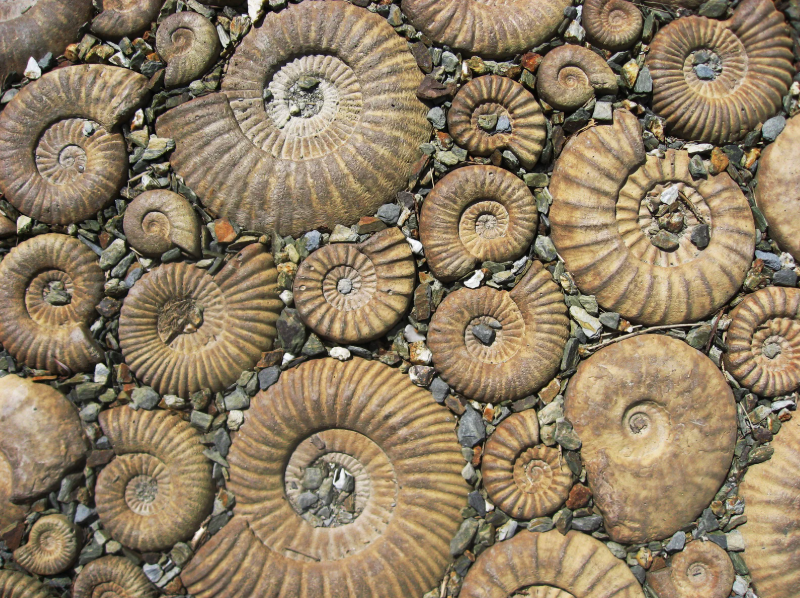
How A Fossil Forms
Share
Imagine you are holding a fossil. (Or, if you’ve a fossil in your possession, take it in your hands for a moment.) Perhaps your fossil is an ammonite, with hypnotic spirals and flashes of opalization. Perhaps it is a trilobite, with cracked whiskers preserved in stone. Or it may be something else—a dinosaur claw or frozen fern. Whatever the case, take a few moments to exist with it, even if only in your imagination.
What you’ve got here is evidence of an ancient life. Long, long, long before today (so long, in fact, that I would need to repeat the word long for several pages to accurately depict it), a strange being breathed. It walked, swam, flew, or grew. It was born in some kind of way and lived some kind of life. Sometimes it was hungry. Sometimes thirsty. Sometimes it was afraid, and sometimes it basked in the light of pure bliss. If you zoom out to a more cosmic perspective, you’ll find that the life forms who became fossils were not so very different from you or me.
Let’s learn about them.

There are four main fossilization processes: 1) permineralization and replacement; 2) recrystallization; 3) molds, casts, and steinkerns; and 4) preserved remains. These processes may take anywhere from thousands to millions of years, and can occur separately or together in various combinations.
Permineralization and replacement are among the most common fossilization processes. Both play a significant role in the fossilization of wood, bone, and shell. Permineralization describes when minerals fill into natural pores of organic material. This process begins when mineral-rich groundwater flows through the pores and deposits silica or other ions. Replacement, on the other hand, is the substitution of organic materials for inorganic ones. Most often, permineralization and replacement co-occur, but they can also occur independently of one another.

When an organic material undergoes recrystallization, this means that the type of mineral composing it is replaced by another mineral of the same chemical composition. This happens most frequently with aragonite and calcite (two polymorphs of calcium carbonate). A good many of invertebrates form their shells and other armored parts out of aragonite, so during fossilization, calcite sometimes replaces the original aragonite.
Molds, casts, and steinkerns are particularly common for invertebrates and animal tracks or burrows. When shells and other armored parts make three-dimensional impressions in sediment, molds may form around them. If the shell is dissolved and its imprint is filled in with minerals, this may lead to the formation of a cast. A steinkern is an internal cast of the interior shape of a shell or other organic structure. Sometimes, if the structure eventually dissolves, the steinkern is the only evidence left that it ever existed at all.
Preserved remains are the rarest type of fossil. They describe the literal remains of animals, plants, microorganisms, and other organic material preserved essentially in their original state. Remarkably, these fossils often include organic parts that are rarely fossilized: skin, hair, feathers, foliage, seeds, et cetera. Such preservation can occur as a result of drying, freezing, or entrapment in amber or asphalt.

The odds are extremely small that any given individual organism will become a fossil. This is because the requirements for fossilization do not occur very often. These two factors are rapid burial and hard parts.
Rapid burial is burial by sediment immediately after an organism dies. This process prevents decomposition, weathering, and scavenging.
Hard parts like shells, bones, teeth, and wood are much more likely to be preserved because they are significantly more durable than soft tissues.
Considering these two factors, it’s no wonder that some types of fossils are more common than others. The “rapid burial” requirement means that fossils of marine organisms are much more plentiful than fossils of creatures that lived in the mountains. The “hard parts” criterion leads to the fossilization of more shells and bones than feathers or insects. It is for these reasons that the fossil record is largely incomplete.

Now call back, if you would, to the fossil you held at the beginning of this article. Remember that it used to be alive on this Earth, just like you are now. Its organic matter was replaced, atom by atom, with minerals. Now these minerals hold space for the original being. They tell us, this is the shape of a life.
It makes me wonder... ten million years from now, when the Earth is something different than anything we can imagine, what will remain from today? Whose shapes will the minerals hold?
~~~
by Amber N. 2025
